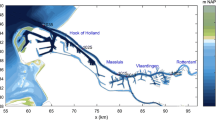Abstract
The results of a fully three-dimensional model for the generation of tidal sand banks are discussed. The model is based on the linear stability analysis of the flat sea bed configuration subject to oscillatory tidal currents. The flow regime is assumed to be turbulent and a Boussinesq’s approach is adopted to model Reynolds stresses.
The eddy viscosity depends on the distance from the bed and an accurate description of the flow close to the sea bed, where sediment motion is mainly confined, is obtained. Sediment transport is modelled in terms of both suspended and bed loads. As discussed in Besio et al. (2005), where model predictions are compared with field data, the model can reliably predict the conditions leading to the appearance of tidal sand banks. Presently, attention is focussed on the prediction of the geometrical characteristics of sand banks. While previous works on the subject always predict sand banks with crests counter-clockwise rotated with respect to the direction of the main tidal current, the present results show that sand bank crests are rotated clockwise/anti-clockwise depending on the anti-clockwise/clockwise rotation of the velocity vector induced by the tide. Only when the tidal current tends to be unidirectional, sand banks are always characterized by crests which are anti-clockwise rotated with respect to the direction of the tidal current. Moreover, no preferred direction is selected by the analysis when the tide tends to be circular. The geometrical characteristics of sand banks (wavelength and angle of rotation) are computed as the function of the ratio between the minor and major axes of the tidal ellipse for both clockwise and counter-clockwise rotating tidal velocity vectors.








Similar content being viewed by others
References
Besio G (2004) Modelling of tidally generated large scale bedforms. PhD Thesis. Ed Univ di Genova 157pp
Besio G, Blondeaux P, Vittori G (2005) On the formation of sand waves and sand banks. J Fluid Mech (in press)
Blondeaux P, Vittori G (2005a) Flow and sediment transport induced by tide propagation Part 1: the flat bottom case. J Geophys Res (in press)
Blondeaux P, Vittori G (2005b) Flow and sediment transport induced by tide propagation Part 2: the wavy bottom case . Accepted for publication in J Geophys Res (in press)
Collins MB, Shimwell SJ, Gao S, Powell H, Hewistom C, Taylor JA (1990) Water and sediment movement in the vicinity of linear sandbanks: the Norfolk Banks, southern North Sea. Mar Geol 123:125–142
Dean RB (1974) AERO Report 74-11. Imperial College, London
De Swart HE, Hulscher SJMH (1995) Dynamics of large-scale bed forms in coastal seas. In: Doelman A, Van Harten A (ed) Nonlinear Dynamics and Pattern Formation in the Natural Environment. Longman, New York
De Vriend HJ (1990) Morphological processes in shallow tidal seas. In: Cheng RT (ed) Residual currents and long-term transport. Springer, Berlin Heidelberg New york
Dyer KR, Huntley DA (1999) The origin, classification and modelling of sand banks and ridges. Cont Shelf Res 19:1285–1330
Fredsøe J, Deigaard R (1992) Mechanics of coastal sediment transport. Advanced Series on Ocean Engineering. World Scientific, Singapore, xviii+369 p
Gerkema T (2000) A linear stability analysis of tidally generated sand waves. J Fluid Mech 417:303–322
Hommes S (2004) Large-scale sand extraction on sand ridges offshore of the Netherlands. Technical Report Ed Univ of Twente 127pp
Hulscher SJMH, De Swart HE, De Vriend HJ (1993) The generation of offshore tidal sand banks and sand waves. Cont Shelf Res 13:1183–1204
Hulscher SJMH (1996) Tidal-induced large-scale regular bed form patterns in a three-dimensional shallow water model. J Geophys Res C9(101):20727–20744
Huthnance JM (1982a) On one mechanism forming linear sand banks. Est Coastal Shelf Sci 14:79–99
Huthnance JM (1982b) On the formation of sand banks of finite extent. Est Coastal Shelf Sci 15:277–299
Johnson MA, Kenyon NH, Belderson RH, Stride AH (1982) Sand transport. In: Stride AH (ed) Offshore tidal sands. Chapman Hall, London
Komarova NL, Newell AC (2000) Nonlinear dynamics of sand banks and sand waves. J Fluid Mech 415:285–312
LeBlond PH, Mysak LA (1978) Waves in the ocean. Elsevier, Amsterdam, xiv+602 p
Seminara G (1998) Stability and morphodynamics. Meccanica 33:59–99
Soulsby RL (1983) The bottom boundary layer of shelf seas. In: Johns B (ed) Physical Oceanography of Coastal and Shelf Seas. Elsevier, Amsterdam, pp 189–266
Talmon AM, Struiksma N, Van Mierlo MCLM (1995) Laboratory measurements of the direction of sediment transport on transverse alluvial bed slopes. J Hydraul Res 33:495–517
Van Alphen JSLJ, Damoiseaux MA (1989) A geomorphological map of the Dutch shoreface and adjacent part of the continental shelf. Geologie an Mijnbouw 68:433–444
Van Rijn LC (1984a) Sediment transport, part I: bed load transport. J Hydr Engng 110:1431–1456
Van Rijn LC (1984b) Sediment transport, part II: suspended load transport. J Hydr Engng 110:1613–1641
Vittori G (1989) Nonlinear viscous oscillatory flow over a small amplitude wavy wall. J Hydraul Res 27:267–280
Acknowledgements
This research has been supported by the EU under the contracts n. EVK3-2000-22014 (HUMOR) and n. EVK3-2001-00053 (SANDPIT). At the initial stage funding was also provided by SNAMPROGETTI S.p.A. (contract number 3000000248) and by the University of Genova.
Author information
Authors and Affiliations
Corresponding author
Additional information
Responsible Editor: Paulo Salles
Rights and permissions
About this article
Cite this article
Besio, G., Blondeaux, P. & Vittori, G. A three-dimensional model of sand bank formation. Ocean Dynamics 55, 515–525 (2005). https://doi.org/10.1007/s10236-005-0027-0
Received:
Accepted:
Published:
Issue Date:
DOI: https://doi.org/10.1007/s10236-005-0027-0



